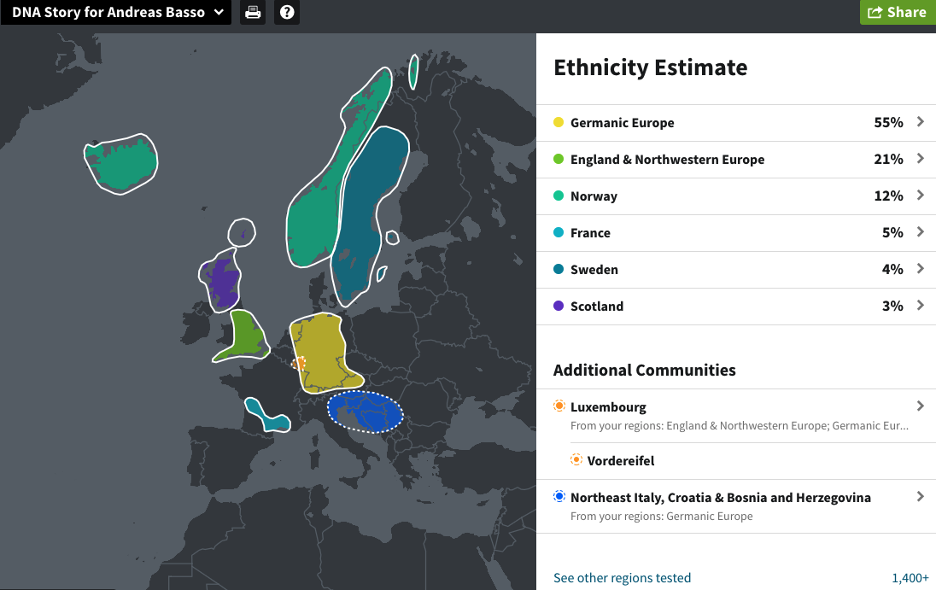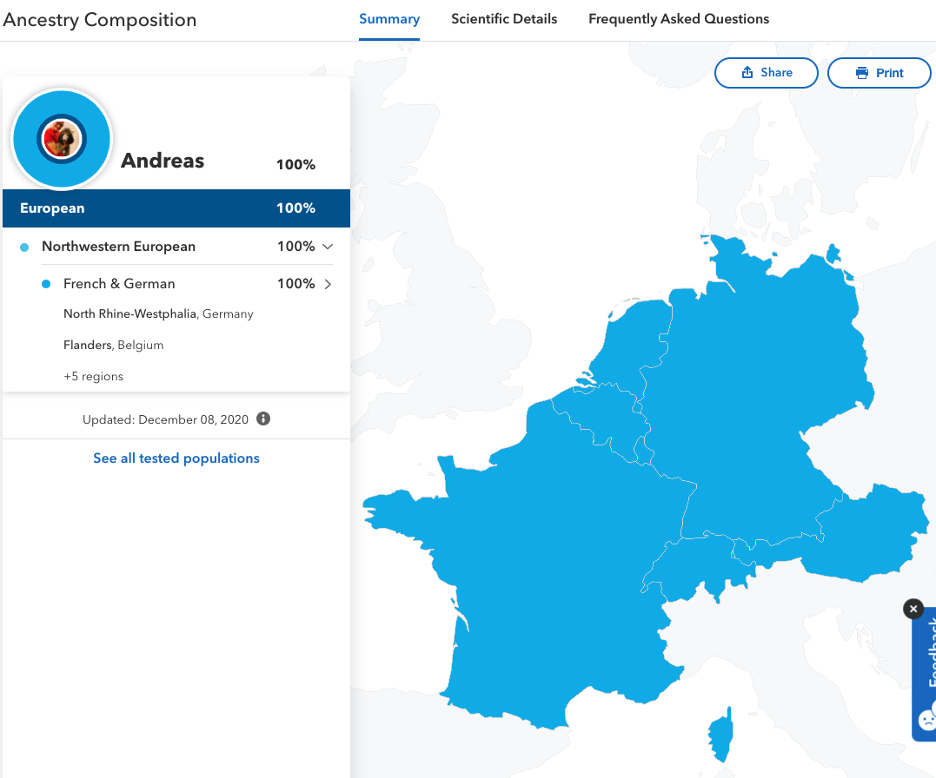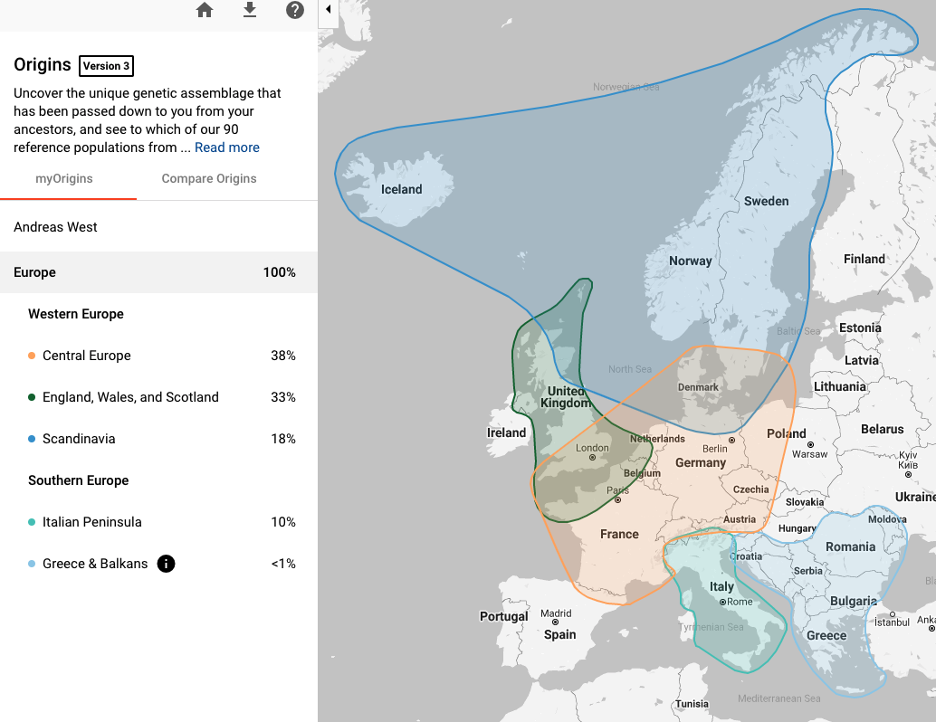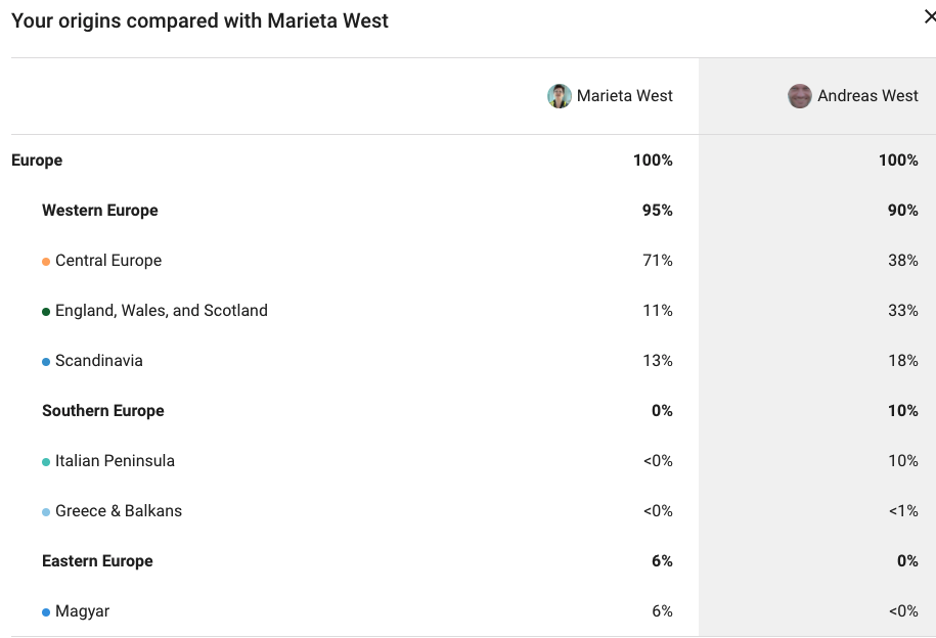Disclaimer: Any views or opinions expressed in this article belong to guest writer Andreas West and do not necessarily reflect the opinions of Germanology Unlocked. Please also note that this post was originally published in 2021, and certain companies may (and likely) have since updated their methods, pools, etc. Thanks to Andreas for this well-researched post!
Meet Author Andreas West:

Andreas West is a native German genealogist who has been researching his ancestors for over 25 years, and has used DNA tests for the past eight years. He is the author of the “Your DNA Family” app, which people can use to confirm their family tree or find out who their birth family is. Find out more at https://yourdna.family/ .
You Have German Ancestry: Which DNA Test Should You Take?
With a number of DNA companies out there – such as 23andMe, AncestryDNA, MyHeritage, and FamilyTree DNA – how do you know which is the right fit for you and your German ancestry?
In this article, I’ll walk you through my experience with the different DNA tests. As a genealogist with known German heritage, I have experienced a number of complications regarding the accuracy of my DNA results. Given the complex nature of German DNA, this is not surprising – but I hope that my story can help you to find the test that will give you the most accurate DNA results possible.
As there is so much difficulty in identifying German DNA (see Your DNA Guide’s Diahan Southard’s post on the topic here), I was curious to see which company’s test gives the most accurate and detailed ethnicity results. Read on to see what I discovered!

First – My Own Genealogical Research
Considering that most of my ancestors (over 80%) originated from what is nowadays Germany, I began my analysis by comparing the current known locations of my ancestors (based on 25+ years of genealogical research) against the ethnicity predictions.
While both my parents have shown traces of Scandinavian DNA, I have yet to find any evidence of it in my genealogical research. To understand this further, I dove into how exactly ethnicities are predicted in the tests.
Predicting Ethnicities
Prediction of ethnicities are commonly referred to as “Ethnicity Estimates” on your DNA test. With many people turning to DNA testing to find out more about their ancestry and ethnicity, ethnicity predictions are largely based on two main factors:
- Samples of data collected from scientific databases (such as the 1000 Genomes Project) and customer data collected from customers who self-reported that all 4 grandparents originated in the same country/region
- Clustering of DNA segments inherited from countries or regions based on best fit
There are, however, several problems that exist with these methods:
- A lack of diversity in scientific databases, especially on the African and Asian continents (which are only marginally represented).
- Possibly ethnicity inaccuracy: For example, even though all four of my grandparents were born in the same town, it does not mean that their ethnicity, and therefore mine, comes from this city or even the same region. I know this from the fact that one of my eight great-grandparents was born in Asiago, Italy and has no German ancestry.
- A lack of precision: By putting DNA segments into categories like “European” or “Northern European”, that doesn’t always help identify the country, let alone the region, these ancestors came from.
- Recombination events during meiosis: This type of cell division results in a random inheritance pattern for DNA, so siblings can have very different ethnicity predictions, and some ethnicities may not be inherited by one or more siblings.
- In terms of self-reporting, non- paternity events (NPEs) can also lead to incorrect results, since the person testing is unaware of the ethnicity of the real birth parent(s). In hospitals, accidents like swapping babies may also have happened.
Despite the fact that the method of comparing ethnicity percentages between DNA-based estimates and genealogical resources isn’t perfect, in the absence of a better method, we will use it as our main quality assessment today in comparing the tests.
It is also important to keep in mind that DNA testing companies are constantly updating their predictions, so always check back for their new updates and improvements.
My DNA Test Results
In order to give you an idea of the different tests and what type of results they show, let’s take a close look at my ethnicity results for each company:
AncestryDNA
2021 result:

23andMe
23andMe offers different confidence intervals (speculative, standard, conservative) decreasing in detail (conservative is the least detailed). This article focuses solely on the speculative confidence level.
2014 result:

Split view between my parents (2014):

2021 result:

Looking at the 5 predicted regions of Germany (2021):

The following two Belgian regions (2021) have been identified:

Chromosome view (2021):

MyHeritage
Ethnicity estimate and genetic groups (2021):

FamilyTreeDNA
My Origin v3 (2021):

Comparison with my father (2021):

Comparison with my mother (2021):

How accurate are these tests, really?
For a fair comparison of the current state of the tests’ accuracy and detail level, we will use the 2021 predictions collected.
Summary of ethnicity predictions versus genealogical-based ethnicity:

The Comparison
Ancestry DNA
Ancestry DNA offers the greatest breakdown into countries, with six predicted countries listed. The 55% of predicted German ancestry, or rather of Germanic European ancestry, is the second lowest. In the case of Germany and France combined, it increases to 60%.
Since my genealogical research so far shows no evidence of British ethnicity, it could either be an NPE or, more likely, a misinterpretation or an inability to distinguish between Germans and British (due to the Saxon history of the British).
23andMe
At first glance, the prediction of 100% German (French & German) does not seem very detailed. A great deal of 23andMe’s value, however, is in the more detailed DNA-based regions that the company adds. Ancestry DNA and MyHeritage, on the other hand, mainly base their communities (Ancestry) and genetic groups (MH) on submitted family trees.
I only have a small family tree associated with my mother at 23andMe, so it doesn’t have any location information (based on the last update in December of 2020). Most of my German ancestors came from those four regions. The link to the two Belgian regions makes sense through my Calefice ancestors (most likely from Liege).
Currently, 23andMe is the only DNA testing company that offers their customers a chromosome map of their ethnicity prediction. In this way, we can determine exactly where certain ethnicities are present on our chromosomes!
My Heritage
While the 97% figure for North and Western Europe is quite vague, it seems they are focusing more on combining DNA with their large number of family trees on their site. The genetic group of people from Vicenza is correct. However, no DNA percentage is associated with this group or any of the other largely-overlapping genetic groups.
Family Tree DNA
Even though FTDNA’s new v3 MyOrigins prediction (from a 100% Western & Central Europe prediction in 2014) shows considerable improvement, the percentages are still very far off from both other ethnicity predictions and my own genealogical research. While the 38% for Central Europe is too broad, the 33% for Britain is simply not supported by any genealogical evidence. 18% Scandinavian DNA is also likely too high, as that would mean that two of my eight great-grandparents were from the Scandinavian region (more or less).
ONLY FTDNA AND 23ANDME’S OLDER PREDICTION recognizes Italian heritage
Only FTDNA recognizes my Italian DNA. It is even relatively close to the expected 12.5%. 23andMe identified my Italian heritage in 2014 and 2017 with 6.9% and 7.0%, but somehow stopped recognizing it in 2020 when they changed their algorithm.
However, FTDNA fails to tell me where my 10% Italian DNA comes from. It doesn’t understand that it’s from my father (whose predicted value of 0% was wrong), and with 0% from my mother, it came out of nowhere!
Verdict and Recommendations
With FTDNA’s predictions looking completely off for a large portion of my DNA – and that Italian DNA coming “out of nowhere”-, I would hesitate to recommend them as the most accurate DNA test.
While MyHeritage builds on the most detailed number of genetic groups, their pure ethnicity prediction does not give you any hint of potential NPEs or give you an idea of where you should look for those brick walls that you’re surely facing.
23andMe and Ancestry seem to be the best fit for German DNA right now. However, although AncestryDNA provides many details, some of their countries also seem incorrect. 55% of German DNA is too low for me, whereas 15% of Scandinavian DNA is too high.
Therefore, I would recommend 23andMe as the best test for determining where exactly your German ancestors originated. When I compare their regional prediction to my existing genealogical research, it is the only one that is based on DNA and is very accurate. Only they recognized the Belgian DNA lead. Their DNA tests have also shown the same detailed regional level for African and Asian countries, which is a huge improvement for those of African or Asian heritage.
But whichever test you decide is right for you – sometimes doing multiple tests will give you the broadest results – I wish you the best of luck with your German research!

4 Responses
Hello Andreas. I appreciate the information from your article. Specifically, however, I am looking for ethnicity and geographic breakdown based on German ancestry which based on research to date, is very probably between 500 and 1,000 years ago. I wonder whether either or both of 23andme and Ancestry are basing their estimates on the most recent 500 years or even more recently. For example, if one’s ancestors migrated from Germany to England 750 years ago, are they going to show up in the ethnicity breakdowns as 100% English and 0% German. Thank you, Robert
Robert, I have documented 100% German ancestors 5 generations back. 3 different lines. on both ancestry and 23andme it’s not showing ANY German. same applies to my mom and for her it obviously would only have been 4 generations. So even 200 years for me is inaccurate. it seems to be picking it all up as Italian as that’s way higher than I’d expected.
I’m currently having a total disagreement with MyHeritage’s DNA Department concerning my paternal ethnicity estimate! My father and uncle were born in Bavaria Swabia and immigrated to the US. My father and uncle were born in Grosskötz, Günzburg and both ancestral families have lived in this region for centuries. Yet, MyHeritage lists 0.00% for North and West European and 34% Scandinavian for me while my uncle’s son (my 1st cousin) lists him as 82.2% North & West European and 0.0% Scandinavian! I tried to provide evidence that my father’s brother was also born in Bavaria Swabia region from the same parents. Also, my other 1st cousin, daughter of my father’s sister, was born in Stuttgart, Germany, has an estimate of 42.6% Scandinavian and 0.0% North & West European! Through genealogy and church records, I have been able to research my paternal family branches back to the 1500s, all who lived in this Bavarian Swabian region. I reviewed MyHeritage’s ethnic groups and subgroups that should apply in my personal situation in detail, and it appears they have sparce coverage in this specific region. Since we have reached an impasse, they have suggested that I wait until they launch a new and improved model later this year. Both AncestryDNA and 23&Me are “on target” with their ethnicity estimates for me and the other kits I manage.
Hi Robert,
To answer your question about how far back the various companies’ admixture prediction go, they are based on your current day DNA and cannot differentiate between DNA from your ancestors who lived over 500 years ago v. those who lived more recently. Nor can any company tell if some of the DNA you inherited came from an ancestor living 1000 years ago, while other segments came from ancestors who lived only 200 years ago. None of your DNA is date stamped! (Although those of us with Neanderthal DNA know it came from ancestors who lived at least 40,000 years ago.) Also, keep in mind that most of us will be missing ANY detectable DNA from one or more of our 4th great grandparents, and the number of ancestors from whom we inherited zero DNA continues to grow as we go back in time. My own 4th GGPs mostly lived in the mid- to late 1700s. Looking back 500 years or more, I would need to have inherited DNA from all my 7th or 8th GGPs to detect my complete geographic origins. Not only is the DNA from many such ancestors completely missing from my own DNA, but many of the DNA segments I did inherit from my 7-8th GGPs’ are likely too short to be genetically useful, even if the reference populations the various DNA companies use to make their predictions were 100% accurate that far back. Consequently, some of my 7-8th GGPs’ geographic origins are OVER-represented in my admixture predictions. If you are looking for a more complete prediction of your recent (less than 500 years) ancetors’ geographic origins, I suggest that you test as many full siblings as you are able to, as each full sibs’ admixture prediction will differ (except for identical twins). E.g. if any of your full sibs shows “ethnicity” that doesn’t appear in your DNA, or vice versa, know that both you and your sib have ancestors from that ethnicity, even if one of you didn’t inherit any DNA from that particular ancestor.